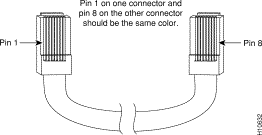|
|

This appendix describes the cables, connectors, and adapters that connect to the
Catalyst 3500 series XL ports.
The 10/100 Ethernet ports use standard RJ-45 connectors and Ethernet pinouts with internal crossovers, as indicated by an X in the port name. These ports have their transmit (TD) and receive (RD) signals internally crossed so that a straight-through cable and adapter can be attached to the port. Figure B-1 shows the pinout.
When connecting the 10/100 ports to compatible servers and workstations, you must use a straight-through cable wired for 10BaseT and 100BaseTX (Figure B-5 illustrates the straight-through cable schematics). When connecting to other switches or repeaters, ensure that you use a crossover cable. (Figure B-4 illustrates the crossover cable schematics.)
1000BaseX ports use duplex SC connectors, as shown in Figure B-2.

The GigaStack Gigabit Interface Converter (GBIC) uses proprietary connectors, as shown in Figure B-3.

The GigaStack GBIC cables are proprietary, high-data-rate cables with enhanced signal integrity and EMI performance.
| Caution Do not use standard IEEE 1394 cables with the GigaStack GBIC. |
The schematics of crossover and straight-through cables are shown in Figure B-4 and Figure B-5.


The console port uses an 8-pin RJ-45 connector , as shown in Figure B-7 and described in Table B-1. The supplied RJ-45-to-RJ-45 rollover cable and adapters are used to connect the console port of the switch to a console PC or terminal. The following sections describe the rollover cable and adapters for the console port.
You can identify a rollover cable by comparing the two modular ends of the cable. Hold the cable ends side-by-side, with the tab at the back. The wire connected to the pin on the outside of the left plug should be the same color as the wire connected to the pin on the outside of the right plug (see Figure B-6).

Use the supplied thin, flat, RJ-45-to-RJ-45 rollover cable and RJ-45-to-DB-9 female DTE adapter to connect the console port to a PC running terminal-emulation software. Figure B-7 shows how to connect the console port to a PC. Table B-1 lists the pinouts for the console port, the RJ-45-to-RJ-45 rollover cable, and the RJ-45-to-DB-9 female DTE adapter.

| Console Port (DTE) | RJ-45-to-RJ-45 Rollover Cable | RJ-45-to-DB-9 Terminal Adapter | Console Device | |
|---|---|---|---|---|
| Signal | RJ-45 Pin | RJ-45 Pin | DB-9 Pin | Signal |
RTS | 1 | 8 | 8 | CTS |
Not connected | 2 | 7 | 6 | DSR |
TxD | 3 | 6 | 2 | RxD |
GND | 4 | 5 | 5 | GND |
GND | 5 | 4 | 5 | GND |
RxD | 6 | 3 | 3 | TxD |
Not connected | 7 | 2 | 4 | DTR |
CTS | 8 | 1 | 7 | RTS |
Use the thin, flat, RJ-45-to-RJ-45 rollover cable and RJ-45-to-DB-25 female DTE adapter to connect the console port to a terminal. Figure B-8 shows how to connect the console port to a terminal. Table B-2 lists the pinouts for the console port, the RJ-45-to-RJ-45 rollover cable, and the RJ-45-to-DB-25 female DTE adapter.

| Console Port (DTE) | RJ-45-to-RJ-45 Rollover Cable | RJ-45-to-DB-25 Terminal Adapter | Console Device | |
|---|---|---|---|---|
| Signal | RJ-45 Pin | RJ-45 Pin | DB-25 Pin | Signal |
RTS | 1 | 8 | 5 | CTS |
Not connected | 2 | 7 | 6 | DSR |
TxD | 3 | 6 | 3 | RxD |
GND | 4 | 5 | 7 | GND |
GND | 5 | 4 | 7 | GND |
RxD | 6 | 3 | 2 | TxD |
Not connected | 7 | 2 | 20 | DTR |
CTS | 8 | 1 | 4 | RTS |
![]()
![]()
![]()
![]()
![]()
![]()
![]()
![]()
Posted: Thu Apr 13 18:08:23 PDT 2000
Copyright 1989 - 2000©Cisco Systems Inc.